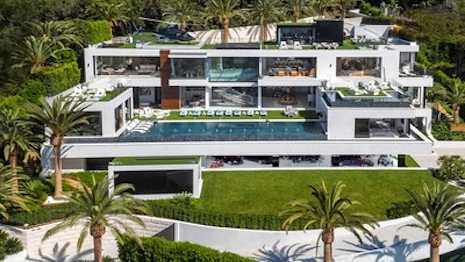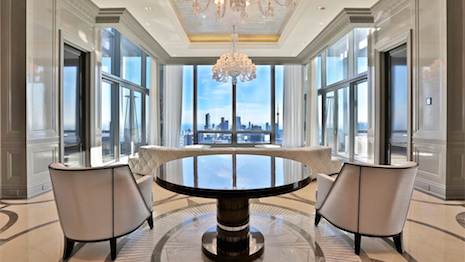The number of homes sold for $1 million or more flattened in 2016, growing a mere 1 percent, according to new research from Christie’s International Real Estate.
According to the broker's Luxury Defined report, on average, sale prices for luxury residential properties rose only 2 percent, and homes spent 13 percent more time on the market than in 2015. Following economic and political uncertainties and fluctuations in 2016, the coming year in high-end real estate is looking up as consumers feel more confident.
"The luxury housing marketplace is influenced by a prevailing and intangible element—sentiment," said Monique Sofo, vice president, strategy at Christie's International Real Estate. "On the heels of an extraordinary post-global recessionary growth period, luxury home sales softened due to a wave of global uncertainty that led many affluent buyers and sellers to ‘wait and see’ before pulling the trigger on a home sale or purchase.
"We’ve moved from sustained global growth into a more bifurcated market," she said. "While some individual markets like Toronto posted outstanding results, others, like London, are experiencing a cool down.
"Although numerous factors are at play—including inventory constraints, local economic factors, currency controls, international buyer demand, etc.—luxury home sales tended to be stronger in markets not directly impacted by uncertainty."
Real estate rundown
In 2016, the average starting price for a luxury home was $2.1 million, slightly down from 2015’s $2.2 million. The cost of entry-level luxury properties varies greatly from market to market, pointing to the growing divide within high-end real estate sales.
While the rest of the market stalled, sales of trophy homes escalated. For the first time, all of the top 10 priciest homes were sold for at least $100 million, totaling $1.32 billion.
The rise of the trophy house appears to be continuing this year, with a spec home in Los Angeles boasting an asking price of $250 million, making it the most expensive residential property to come on the market in the U.S. (see story).

924 Bel Air Road designed by Bruce Makowsky
While breaking records, ultra-prime properties are small in number, with about $1,500 homes available on the market for $20 million or more.
"Despite the slowdown in million-dollar-plus sales over the past 12-18 months, we haven’t yet hit a ceiling in the trophy home market, as transactions continued to close at price-points over $100 million," Ms. Sofo said. "In 2016 for the first time in history, the world’s top 10 reported property sales were all above $100 million and sold for more than $1.32 billion in aggregate.
"And the ultra-trophy home market shows no sign of fading," she said. "Already in 2017, two properties have sold for over $100 million—one a $360 million 'teardown' in Hong Kong."
In 2016, luxury homes remained on the market for about 220 days, up from 195 the prior year. City locations saw faster sales than those in markets where buyers are often seeking a second home.
Hong Kong tops this year’s index of hottest real estate markets, bumping London down a spot from its long running position in the top seat. The city-state had four sales at $100 million or more, with interest in high-end real estate unhindered by new stamp duties.

Hong Kong; image source Christie's
Toronto and San Francisco are markets heating up, while Miami has fallen in the rankings as an oversaturated supply has forced price reductions to move properties.
Christie’s also notest that beyond Miami, sellers in various prime markets overprice their homes. If enough homeowners do this, it leads to a diminished interest in buying, and sales volume suffers.
From the previous year, the ratio of list price to sale price dropped as sellers were forced to reduce their asking prices.
Hitting play
Christie’s International Real Estate compares 2016 to buyers hitting pause while they waited to see how some events would play out, including the U.S. presidential election.
While U.S. consumers do not typically buy during an election year, they may not resume plans. President Trump has promised to cut taxes, and if successful, wealthy buyers could have more funds to make a home purchase.
Because the luxury property market shares the same niche, affluent audience as the overall luxury market, it follows hard luxury goods trends more closely than the broader real estate industry. After the recession, these individuals fared better than the general population as their earnings grew at a faster rate, keeping the luxury industry largely insulated from the fallout of the crisis.
Following the period of growth, the industry has stalled as challenges disrupt consumers’ spending on luxuries.
Bain and Fondazione Altagamma’s spring update to their “Luxury Study 2016” report found that the slowdown of 2015 “seeped” into the first quarter of 2016 with only 1 percent of growth. The slowing seen in 2015 is attributed to a lackluster holiday season in the United States, decreased tourism in Europe, Middle Eastern instability and slowdown of China (see story).
Consumers who are close to achieving traditional wealth are largely positive about the status of their countries’ economies, according to a new report from Sotheby’s International Realty.
The majority of emerging affluent consumers believe that their nations’ economies are currently strong and headed on the right track. Beyond confidence in their national finances, consumers are showing an optimistic outlook for their own economic situation, creating opportunities for the luxury industry (see story).
"For affluent global buyers, luxury residential real estate will continue to be viewed as a safe and attractive investment," Ms. Sofo said. "Currency moves will likely fuel increased demand for prime property in stable and safe environments. Across luxury housing markets globally, we expect to see the continuation of moderate growth in luxury home sales.
"Luxury housing markets in small- to mid-sized tech-hub cities are poised to continue an upward trajectory," she said. "Markets to watch include Victoria, British Columbia; Austin, Texas and Portland, Oregon—growing metropolises with homegrown tech start-ups, entrepreneurial incubators, or that serve as satellite offices for global tech firms.
"Regional migration and a strengthening economy will likely boost these luxury housing markets in the year ahead."
{"ct":"4TqZQAt2WvDZwfxY1TGHUPU8hIPkcMYKReu2hztFPvq\/OmssTe1hkTJ54Z2SARFD68FPdjc2AhCd2VZhMrhwzmo\/5yvbeN0DnLb+Cg8MH8QxKt31KRgvS8zlkDx9wfRGeDiP4+zAxECaJpVE488\/3SgzrotUKXoycAy9XTVsaCmQb4qk5alBgagncaV6oXlnkGJg84OaP3TFbcVKcKjDT9qgL4nHOcMncSRWhgmJVMGOKQRljDZvyCR+yCuCIRuDYqb5FsHVipohwKYFkhOEtsOmstleNO\/n80iAjFEyXP5wVo\/bP02LKi0BXC\/KJR0kRT7e3RVux5djb6s6QP+Rcj9pZyGt4U1keh\/3yrPQxHV1g4L2GWOUu5bxZISl871Bet05ceM9Hocrd3tsA4e20ZhsyeZl7A4\/FLuqkeQId3KmHAYt4oaP276IiIIUr3CMi+qCX6dMMW2Xgm6KHwX0Su\/cGYmHxClT07BT\/9uv69bQ32FfbBnHjqj\/GVh5PLtGXk\/+M65r1Kw119eJG29ohMuRJUGhFGdUcs25QAzUyPQfC+mIDxRGp6+I5\/I0QuHBEl8zH2RTUT3j69L1TLSlbzFlYphuLZ7YAoPRBfq\/N7No3PSQeF4fyFgyk6DCSc+Uw\/6rO3aTlFc2diwe6z26NEyhwkGeFuzWKtl4YN7NqUjPzklU72w99R05bbmd\/GD1tqugyr1sEURCWTEHszhGJlXZUFjPtnYVg\/xstxsLKVpwpG52hbXGJ5g+twqQAsUO1r2k4UTNIa08v7YJhdW9+RKMX9RtFc9VYnM3CHgu\/coYXraWZfhaA7RmEYCJfD0J0nRF6wbNqa3LAVe4ilt0eQnpGlb+s4SN\/WHvBZBZy+6lrXCdim0KE3LTd7G\/yFkTrneE5gIOUIK\/2FI\/pnIOL\/4bd6o7cnl7J6i9olEynerxbcOvGRtIQTlQ1Ow7lnp\/\/AfGrh+4mAavy+HeI2XTdP8XhAkOGPJhTnApL8wL\/z6utrsDJCuY5H4UkM4j2Ii9FqCYj5bNbmKYW6F9dVoLxu1yYJHiiHaHpfcGwVXw6S6SG0LjOkwbQT2rggt1KLO\/OLp\/xl8APxnapSsUWYj0ovnDEoT\/IqvuDN6pHEf2oa9lFkGvG12nsBhs33i0ihxB2m+9v0D\/ambW00YxOYfR1K8FUFu1EhaW2n3veasZyjY5rEJ104IvNiP9gU9BpOoQCWAF+mNh3Hvzv3K3MUy9V1ytZpG1Eo3H2YRUhDqqW8AyoYUFBRgYP3WkjeszWpnPfReEPMjE9n6pacifsWQJjFgMIBmthTwIvcW44zVQsAPImKiOcO8rVJhcE6KRr3f2VQ4aVVA232IcA4xUivCwRTmNgFMgX3w7pUrksqpdRrIsxL2j34T+DdhL\/rWE09OpZOndPCPCnKyJIQALyPM8hhMJh998fz2AJprm23d7GeVlaSfJ2snAzUQ1FTgu4P0dlTPZfgtBhs4VEtlmUo7oJCZRPGxt4RLkErEFH+2s7PzjMNGBhAnYc5WDmH9fEO\/7DWJuR9lA9NiqDo8qzp0+uJk7nLHVYemkhZZuzezC08w\/+LZqLVwJizoO2BfDOtp\/e06MSg\/z0bNjZIIGzzIeom5VpfN\/vG+GGdyGTSP9WO3kDn3mr4zX5WBcEpWYS5Lxrp2zFfvA+eenRXmAoAAoaiof0SQgdLrmbsLSXJ0D3Cfb5V1JoVgOqL1tNthpCAgSIwobQmTkkd1IdBhFarfKc4CQwlDpRJWPESvreqeGBf7k+EUxeRUB5zDe6vMZIqMX1cMfPHKcVUPSr9+7o7sZwVKS0AtA514GJHZQxzuJjcCmew50UAdQU\/SLyH+9lUvjBEaC2641DjSpLxsHuvOt6BvNhOrEgDwvRb5mRdvwwqNAVge7vE69ZObNUxuPw91I9\/K6wrrsrR0mSgHO510xN\/FqxJGs6\/ce6KVX7m8GM6Q9\/wwFSRvEbu6HAXrHz8x\/RBmOfwANZ3FfLbKFPLodPmETB4F4N6II7IXK4ZGWH34OWF2kGKm+NJaM85sUbSlgTuxU65VqRQFZGtBo9L+Qi5W1dJAsLueSKee9c2UhUr7QBcNpG5qBgmiH7MpXtMeUNhyvQQD3\/fj1+gTUE9lkFWK5WzK4NgJ+\/144ktVx4DxKRoaYF2dLQtkekGNbvhfbZ7eJo\/RlYsNh7dKmdaEg+fvnwn\/0G7srg35VzKhpS4tCMfAWjxfmPCrWjpKwSVzZPrUtA6gg3qWbDQkcQBXdF311NmQNGE5wDeJx\/aP89JWEV8CF4boFcPM7ZPnpuYhcNDtXD3L1HHbGoycuMSWUxUtbFH1DFChe96gBHxaz96LmYg\/pOjpmuV9SyiI0hr3+UDqT0ssjiUscgXDUjf63Wtrl4\/3WRQe3mrygTbRigWL4cg64NY+GOeDmOkAqsEFWp5votft4RjBxCx6\/o\/4szJC7bGG0hd6ESElfTbU5eHhlOQmG43WvSfpDl7GtuJETSYR9aef1XB45a\/KCXs9tPoXL840W8opW7AbLdiNpEDQrrmP5KLUBF+VIO1AsfmBicvNXjQNCvbRCrgNB9SLDgecE+ObRDEJy8H7XSB5TQbBsjGeqg9FW\/WVQa7hF4iu\/pZUDvl9kUaRumEWkf85NPeZFr7j3PcgopIIYOj2sRNeOOXYBgvaau+rxBq3Zj9Bijp+5O6eUVe7FPDz3VUXc9+CB\/20vQxAMcD3T\/tpQk2zUFChBV0mZHcaD5fgOLhKKt\/9jPaPRw1ZW0k8KwbNdvDL7Wu9N9Vl8LyGa+f25fGOhGsddE67nSXsxXYPDcWbgtcaRmr4ekr9CII1RQY5odM4FGrApPqF76qqUMEkp5nl3Gdtlf+oLXxc43fe5aP0+5QqQTrOu8b0mic6JSnkCzpwlQtmfy34Vx1Xusbv3I9cfQVEUm9GGXFb8RjoAScnwf0H\/vcXv\/5lnRAbppqHj7CeS7Kw11ilix6qMWhihIXVYpBFSYp9FMkPvSRT6t1VPh4dHtdOKS\/vuTMqGyNPscvDs3XB8p3J46wuwWUFHrFlDdumQakUMDY6lWzk7BxMK9k5HBBJoQ4WXfQKfKtlfdihUoznWUwDHEhRbU1DacjHvqieLlEDsLsgswGUndjkrCAzDK3ObCS1+duZtRC6NHJfOI9\/k0dadiDtbu7NjkVYB148nk5uvsyB1Gcg+FtNuggiMqfS8A505UIbHQO0nCTYy9KB723PmMpAh+NapMc4VFRknd5QVYOTd0Rl13fLtTjHOKAn2nQBAIQ1Hqtx6QmdUp1rrTUad0yRN0Zx47h0cs85SRSopuksVNPAXRjgTu3jBWmH3loDkdS4osBO8gmy\/Q64iXPDPx+auJf6ECZoX4yedHcRKC0cmmiWLe77MNz1cILnOvx22tiSr7yMUAXngePNB1fcbW6Xh\/HWSvRDysjgmR7a54yZ2645sv+lRUAMXSJ9AAoJmWpTHy+epZWD8b69l8+YqhNoynEFXiaX4RKqre\/t0Oc5sxKN9Xe\/9jcO8rD9Cc7fs\/E6qLaHlgKp7WQjyrmoYiXrMWFOiWYNdaHEvmviV3hPuVrhHZKbCy91f2xrmnKbMWEdK2yJfVJaMGeAHo0QuFy14Q6UMAGMMeUTJEgTEhNg43x\/jtMRiLXuqBYrXqVHszB612Cq4PfAUAnp9awqHJj9R2Fyw7Eyeykm20A+\/z\/7HhHfH0Qws60su0zu4KuoLeN8T9qo5Zy5FEhM0GrqcgunXSUiEaDy41pbW8hFTifHyPedjrhsHf2A6B2F6yhURTS7IUO1XJHdndse8+ZM1f35i2JgxSbQof61Q1GbVq5pcMcNN5xQPFzDkNGGlKA3AqFkkijagRH1qoLlvjq3LegzBKLEDP+2H7iy6hqo\/AOU\/YJLPLH9px9YM\/hTkgyGYuFonUCw7V5pZY43\/e9e7ZqhdRD6rnol68F5TQfcm4ZCsm\/\/uRLGK1QC3yYkyxjUbCF+buzMxClIzbPsu0Rq0Pr4DqGgR+MbzDTBgEQWsiMZ64\/bMV6IwevOoqn8sRiInsDM6d+k6Gvomf6l8je79B1QniR5vbWr55eEOSn8Ip7wED6SI50H4tgIUhWUFW7FoFWsSZ9W8uF8H0VX7CsE0BrnQfM\/qgdo2lNXrHBwK7TJt+\/doDu5MCtL8nh8wLpAU7UQGqqN\/u6wfqv1S2\/pKYcCyOeXu2D9TzvclT9F5KI3wGO2dwTBvo351hPDfGm5xP+MpyIojlkqaBD8gHVMk4N2X2DSH2oyWxSL0e4pfj+WSovN7lHQbZUD83mzhiE4k4DlWfaN59HNx7DHHBRcjj+suSIiuDLskc0bKvE81V+QQktIdwkfGWvhnnivF80bDvJOUhUmonPpSArErSClqoMRbJZZ19hnyoCiwhAiacOuaNUlOptfPR+mqY9nS67UIU95DPV28QLwJInBvBlz4o\/R\/+\/Nol62W1EMgpkxBX1vM\/7Dx\/Q9sZRq\/SV2VhV+axm+3mLVDbT0dtTthwZcFk569C3fFiQPtTkscHFdsXVWPTghk\/cTLPv03q5C4eU4xy+YHRYZQJeae0djW+TwtlJLrQ03GHPV40n\/31jUnKnJ2ibcrbh0swAOjd+RV\/i5\/kxyByhFSjjCA84ELXRuyGidmbhU1DCAV+9qmG++dq0xqlQ9k53IJUwUlzBe17lMWZtvFSXdG7St0+EZR6Fj7iPaXdekQrlDEO\/AXlwRpsM7GqY4CjcagMXLFNYzcyrkXTW1sdMs624EC49ZPJgtC7EEZxunoCNuWWOzSCaK8Psfr62YwH81C0\/pDVfd+VIr0QNYNq4nkLw+YbL7VglstVX6CG3eNqOlFMYbqrL+LjWCrRPPxedU8J5edxrCzgUqrOovHbM3XkpwnxFjFlfOIvr\/0HZv8FjwS82hI6K9CxWRueVXVw\/MSIrXSMqqVwHBMtwj+MM7CYAYRroerE2nNWYeU+WCC2Yy80tB2tyvE+tJyUmXeCkOdSKuYXitYllMIsbHTOR8VIjfEI3jDUInsGrTPjlptP10CztJ+UzZzt16d2D3gY9nsiErGZhMNjJp6hDG5w+56eHWTfCm3SaWfg5Wyv3\/+1K0eBOtj5Q7wpnYPenFXsHjiyuiymrgqyVRp2BAJPC2Gz6YeDdXkxlx58EWVHC12GxFEwEbpSSMXhuOMVOrm0EyKZsVzSo2JgNEuTLjgk9U0U7uE0\/6ok6o8Zwn8B5Y5A0xbJ52GDG4a0Y48iDmxRRImGNc7Zgc1+ZLzEFJTkkTEKMOjqoaUDNEw7GMpB3PZs7iP7CPQQUHkz90hMzsnIyTcaBkmp5qIlWYfWHMWFf+F841jbmsN1J2Oo9mrJDYeW13g949WSdvgae5iZWTaPPKgtUVhkOz0w\/2gHHYFnh+UiU1aUgWGslKEkey2XB54hHEwh\/L29RLJw86WvRpL0PD9ktu2TqZ\/+SCMJDHPy72lb2In6Etfc6KwHhpu7s5k7CScJH\/HwlJlfHYlWUP0zlgfkg1dNkJNP0IFYyIOXhzD02W8CTKUwgzCPWXEXGNYybDLCz5KLLf0RGv3932kgI99OcCprHst6xg9AfwEtgz2W+ugerUZ1ObEQpiAewhD1NlnC9J96cNAOLf5374Qv2DGitRagk6WkECNqy9ZOwytbMVRrjAvR2mAomuOoOcV\/FffTi7O30GnwoBKHIeY2mo7TS2MB63lwCc+WYAV1fIqRW4OQhjIAbWcecmrHzADsj1s9hGH4q3tRpFU7PjzMHy47QB2UhjyT+Z4NfdQkTtbEFXSjOzB8UFRBoVkOkxIlV7LF2L4PMmqnVosjH4RSTX+MPm7oXSKuSkD4YvvgfxJCZDUBHhAFrOwHkIl3DfjVkcrQlvUjj9dtdVavI7hkoAzqrncZ2iCX2agNl+bYxoOMxdkMQ0neH5I\/fCYR5Rhc3Sqq1mU2xZI1DhM219DdsicJPNcRGhBWw5b236xB6Lo5vq7p+\/nzjEk468gCT6wj8bFm6MV8gBLwGkfFwn2g5U0FcNZn9IEspxJmG2aHOK7B9LCK22X8LKzb5czmXoofsKEr2SHNUwzPD8vPjlUriEBtDI6c5WN0XWObcWT6Qf3708eZW7NrKBQdlM6143cSRTobq\/RUiVst3RL0oPOLczzehBP6dtHIQjYrxZf1JIU28oCFLrju\/sWWr9MSmKP8bVwiDD0pC9wzRCWnWNcYt+jUGG\/VrnoNcqe91zXqmVZD3dNEeRSveCBNALRtS\/ib8itL4\/JaK3L74NAZIoQ8tNnCRujohjJgrRZioAA0kkx4dESFQ7D69VutUcED0dyj+4CJaC+I2tY+rqn5B3+0bj5\/WJeYNI86Ig4dWh8RqtuSw2pqwy8TiOeYOTTznlsCRA2qLVV4f257zbo74eaDNeL4+IxizCsdlk02FpetjbAs8g6tNPhsk6eErGzhyqAKQVDexNxJxzyW8ZpQxjawU8UzFpFUD2b4O9cqIVqein+Wll2wIX3B7PkIV8n5sGulXqI81MDmnomwwmJlKQWy63fNwJM5QdBDCvnCo7uqgzPfgOqXbDaCMsNkAGqDz+mXQo2kHYZrhGCjTToy8vZd2P+39lC\/SFiCrP8NuPYAkh5JPfyzeifehubhGd1r0IUB483n88E99QWsRfwYKm7BSeWJy3y4CSwFnZ8nePMNig44s2hsFxfdEiTmpR4L9RFFm4IpcBbWYncC3baF8g4g1N3ga8ZBkFxoc0henqbZVZaCzzMqxHy\/xBl18FuzzCCYBPWSh1TgXvy9iRi4HPBNXLRhqAvXKlw2sLxmFxdfxLnHKP7QjmQbEnM7Lfghq\/uxxChibO7sumxXV8Nvd0BlEVEBNuhK68dxRzeqR0ysDqE+mo7JumkEgzrYG69Mjd\/pMlYOaItNRu+yv5R55RacjVOX0Ray14JVXWlomXMt2igTU+3WEgi04TDGGKiYW6IyLCq\/kVerpmhLkbFTdF0902\/fcgBSoRMIV5BBXNDW3s8PXeCG9i9GehODzJM+qRWyu\/qJdj\/81cSn+TXbqZqEtdQ3XNWG+QqrEWOhzM1hDy2CE4Eta73fz4n\/RV\/c3cgyD8l4Xh9hthjSsYakrkPWFA+IbOxeFkIyUwvq\/0RoCjU5MUJd8zPOAHh9XZnwm0++zD4ko7LGjvykiU2r\/t\/Yssc1d4n5NE3zbkYy3zoHO9ufvmtrvm83IYveNcsbecHCmzgyYp6rx+l6Z0MXx4MaDsyufd+JBTJ\/8vHninZyNMXLAuTcTDFU\/haD2yePZ2OkT4ls7ynPwnut75goemI1aiQB909LhaFc0XBJOvNAm0oDRe7qTf\/LU0VoN0By72H5NsHhDb423mBSTPvHmO88BxNq8QuFsrJD6nhpL6PbQ1vV4PURgtdpvKPKMC53g77CSeXUVO89ETDj5WUAxJRZoxvIN6x9TME1zYgYBCra++sQIHSAGrI1iyrzUiwjj8G6dRfOqUvXQdG\/J++Pujm7ei+3MjryC2CbFfDCjRGgWUu00qpL4trYxULifOa+ltB9dDulSOUmv8hUfjbhlYIKgZapdLNy6bFhhLEDRIHnXzDzUSPFqakS3++2dPEkW9KG73lYQ2PRI7eamzrk13nW0IbDGjAD4jhOy1nie7YwdoHSHgmMxzPT0FRLXQo\/cKct50CzJQRHGiAFoK1ASKFyRhjkyl97ay2hnWQu8X42f02+CTkbvxwkPbQGcru2W2j8vGTQFTg0bCt2Jr0DHV43eo\/i60APt\/mEHQ+ac3gHLuIjCS50XILtjsY1tZ9xioqnhU79YcgnOcTucoh5hfBVflw7+AiB2wZTvZhQlkKI3vg0Rzn1WBP+yFFoxb25VlL4uTfDilDnrW2v5\/29OwGMlozJAGfFQBBPN3rNFr+ylXKB8nmS8cmDdehDNkKaVb2t9O1SManU4\/5vq8uwN8LGu34XTQnV+JqFVYyEKXKIIQ7rBhSU1P7x0Et95DasyKFotumYDKRieZQ4DPLZEyP3VyP0LitHn3bBYtf0Rpx7O2a4CUb9tkDdk2nEnmOL8xr1dGYuDwzcRTzO9fQ88npwEyo2otruaV+isoIWfhtbpfmuC0xxVRJWqdnrTo+VJF40spJJIQsu8NdlTdBOzCCjnFiM7J5F6JJf2Rxzeg0QtmJZSmm3M1TCrSYzs\/0b\/pQfa5cIa69p0+i8aZ0xX7lSBCuj\/TB3UBu5g7qpPkrz8TutXMN\/+6aak9wX9pmbUpX2r1r+9qfRRwlKqiqTSnFbaT5RmT0LzWLeOHXdcYZbk4H1mNwISXQEL5DhfOLx3XG2gzF3CGuoIt+Ozu3WHBjAnCvxxSKJohC3SY7U57D+bjIlxNjSVe98WcPAZStVsdtY00n1l51QqInhiTVJztL9IwixjiKW1iH9TTbqD7YFaxXDWO02jd4O0a+m0RXe+\/JsICzkLIaLPdIaK8LBZAaw1A0C7TGWKuQJ0Sm3NgUQw1YTexQdIzJD3o5SHjBkMw9N9iuNUnf4TQXSNgJIDfJFxGnRGJQnnjzoIVvtpstKlAWxYUrOZf\/kG6kZsjWBDhSlTGgJxV86IEbqYRb6POmRtNnDYwDidJTrTkRisF20oS1E0fc2kcrpNUvIwKtJxHiTWDrDWaRdsxN0ckYGHECkXjgoq4\/A+OsnVttY\/h\/VhvnkKkWEItYr35pqCmqLbl+VdL0toxQJ1mqOBqVcjAqf2WJeEtTS5AQe79T4BYJ\/bpT+mn2\/YjDafqC4NZ1pKIR14ndF1QpfKoFGHOiSDkyLwhC1UKS4Ss4FQPmCSuZxVqxqPC5OfvNCRRKoMiVl3i91rCFBkbfFBd3FBbG8S+ddf1zsBQIZEDcIbizdr3wTsI7ShsihPBqX9kPiSnIrDMZUKsytbd2vkfsY\/wmAdOF5QVugnbeFYevis9nC+cXy\/npODRNcEBjPVTTyAkDrpdPsy1yj8nsZQx0xMz5ib6BkrDJx4ZuLBckQozPWV+MHWnyAeR2LwNtuv\/olANRobii\/bvOqmv4hjUhOyxC+Q9b3763mRSFBAUJ7xS44+3sCAcug2H7vI+EGE2OgBPLHQYLZNo2HHcnVslhxsTmDA0VQMjyWXO06zsHo3ntnHH2M+SQEQmKr1\/ROxD9Ww0AHwlYF0s\/NpkzkVMybKYtXN8u7YrZ\/Am8GVY3HwmvCUXPuFl9f6mZ20YuH6KQWcQkNslKJBP\/uqrANn1Ih7vqKT3FnfOm4EPqP5z6bZfwiZNFGgREXUjHvlR6m98t24+0OdAu0WXVwmMJNabUvwXXa6\/0U9nHaFcyOnV5jtqt3eSfKvrn2NNM0A6Ci5ArWzpWEcZlaeuTQp5ZkKvKzQvOGoLXgEUzhUxWyspnN1keg6BwWibNFmTBg7fSuY5Qr9k4b0Mw9Hb9UL9BbnDU6yLM1KEhTaczMyce3aIZIkZagODIU9eORw\/z90NIdAMsSHtfcNH5AW7YDIDRQaob33yFSOa8DIsw8Ct9Nn6UUzU0mhmDbgeGztI38rLTmqvwr7fyaC45gJDR1pe0X3BH\/fhDXT3pOT0mpdPmC8Of9006F07Xrh3q5xuY8224FUjJc13evMlMOaZoicL0Y06KplKNwqKubYgaveRIjvBpdIUKL2Z61E2fFAOv4TruiNdibEzpd0Pkjd\/1HPPplq\/3NG348T9jQUlYmMpXXp1T07QsFfKAGFXQVcQXR6NJg2crxKsgbWT0RNmiOFyTND1ofAlGLhzVsyaPqTtChni4f+ioICIi++EdxELl6N8ir32vaQ5zC5pn+e36u+9A2cDQHqavyyXbIwP4am10dOwGM\/fnQstUb8svWV\/I7BJXWXXy2vlpHJhHobJtMQeBez0jxg88fxWO1NJvMvNHu1raUaUGfdD7K0p218\/jy0LyJDt9gPuzxsDuyoR3q29LQoowDLDH6F4brPyoJz3ycT9kPml6SgmVRNVueXVCCcQ9K1ExwcS9LUwA9hGmlJT3bvhSYIF44Ho4hv1rrxhBjVfB\/xbZo37OPQFldX7Z73LU\/Gaj\/Zr9+R9kO8k4BTH26ootD7nKbqr8GYtfaRstLBGqKK+hu9uTnnJwHANe09Czw80mK849IWumnGm4CMOVkvpvYHZSdTGoz3e6pZJY5ARTN\/uT46uC6tZuqGXjdEw628R3Ok6d0BZ3p2PT6393WQrl30C6ihjZN92rS+ysgulfESchu1NI0X63giDdOByHNrqn5GciPEpaNKuY5BPiSs2tqG951WwHczBnHvyWh9egcVbPZvDegUBz\/CMxaZ4kj1k5zaf87jwgNFOy0ZuuK+FcvZ2oavubxNQzcw7r2BIS7NDhLBlg76GLUZYCsOQPTB6j+4tPrmcSIuhi4p7MW5nEHFRjLTJHIXpcZeEP7mnQ34ibcQ4L4a8PJP0yeib2LoK\/MIUHeEaZIH6AClPdGcYQskJEaq1uFk\/\/pOcENbNHK7DuROudmI\/gHLGl9n33s+uN43yrdN\/ymxnRoMjKvBp0pYnatOcV0xf2gBZgk4iZ9Eu2NHGPy+bEK2093WOHHtKBYuAlIuoSaNAY0eK9qdhFNCrSv5Lc4TZrVV2cCdD0CpV4d8twTCKeqF6X9Zj7pxg4rQ3MLDrsFAjjx1Clc9pvd0v6I0IoyLrnGVUOk3D\/ehNwnMWsiJEfinN5uW7Y1RmlQjCYg16fRuM7xkR7M2XjEtnrlNRNy2Mq40k2\/zTgc6HToFSZU0DGHQ==","iv":"bf3c05e6f23d6e329bc6f9f6a96484e5","s":"0135a8e901c47cf4"}

 The penthouse at the Four Seasons Hotel and Private Residences, listed for about $27 million
The penthouse at the Four Seasons Hotel and Private Residences, listed for about $27 million